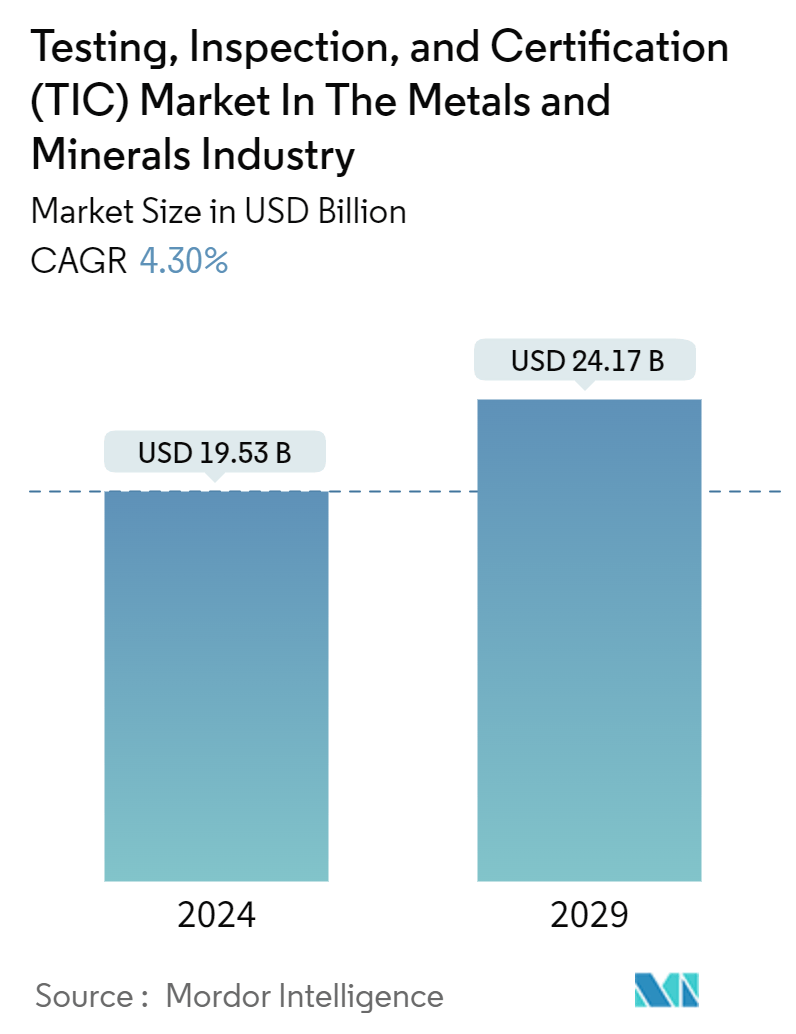Market Size of TIC Industry For The Metals And Minerals Industry

| Study Period | 2019 - 2029 |
| Market Size (2024) | USD 19.53 Billion |
| Market Size (2029) | USD 24.17 Billion |
| CAGR (2024 - 2029) | 4.30 % |
| Fastest Growing Market | Asia Pacific |
| Largest Market | Asia Pacific |
| Market Concentration | Low |
Major Players-Market-In-The-Metals-And-Minerals-Industry-ML.webp)
*Disclaimer: Major Players sorted in no particular order |
TIC Market Analysis
The Testing, Inspection, And Certification Market In The Metals And Minerals Industry is expected to grow from USD 19.53 billion in 2024 to USD 24.17 billion by 2029, at a CAGR of 4.30% during the forecast period (2024-2029).
Testing involves the determination of one or more characteristics of an object or system according to a specific procedure. It evaluates a product's performance, functionality, reliability, and other relevant aspects. Testing can be conducted in laboratories or on-site, and it helps identify any defects, weaknesses, or non-compliance with standards or requirements.
- Inspection entails scrutinizing a product's design, process, or installation to verify its adherence to defined standards. This process involves a detailed assessment of the product's physical characteristics, operational capabilities, and regulatory compliance. Inspections are pivotal and can occur at different junctures, such as during production, installation, or routine upkeep, guaranteeing alignment with requisite standards and guidelines.
- Certification is the process of attesting that a product, service, management system, or person complies with specific standards, regulations, or requirements. It is typically carried out by an independent third-party organization that assesses and verifies the conformity of the product or system. Certification provides assurance to consumers, businesses, and regulatory bodies that the certified entity meets the necessary quality, safety, and performance standards. Testing, inspection, and certification (TIC) services are essential for ensuring the safety, reliability, and quality of products and services across different industries. They help protect consumers, promote compliance with regulations, and contribute to the global economy.
- The increasing global demand for critical minerals is significantly driving the growth of the metals and minerals industry's testing, inspection, and certification market. The demand for critical minerals such as lithium, cobalt, and nickel is projected to increase significantly, driven by the global shift toward renewable energy technologies and electric vehicles. This surge necessitates comprehensive TIC services to ensure the quality and compliance of these materials throughout the supply chain.
- Stringent rules from government and regulatory bodies, especially in the domain of high-end industries equipment certification and energy efficiency in business, are compelling the organizations to leverage testing, inspection, and certification (TIC) services. The TIC service providers precisely tailor the certification programs and the appropriate testing procedures according to the products, enabling them to get a uniform quality standard. According to the OECD-EUIPO study, China is the top electricity producer, therefore requiring a growing need for TIC services, including outsourced services.
- In recent years, the TIC market has witnessed a proliferation of regulations, standards, and certifications across various industries. This has resulted in a more complex and interconnected supply chain involving multiple stakeholders, suppliers, manufacturers, and distributors. In addition, globalization has further amplified this complexity, with products being sourced from different regions, each subject to its own set of regulations.
- The testing and inspection industry is anticipated to be significantly affected by various geopolitical scenarios, including the Russia-Ukraine war, the China-US Tech war, and a decline in consumer spending in the semiconductor industry. The semiconductor industry has faced several challenges over the past two years, including the COVID-19 pandemic and a lack of capacity to meet growing demand. The crisis in Ukraine is the latest obstacle to arise, and it can potentially cause significant disruptions in various sectors, including the metals, energy, power, and manufacturing sectors. This could have far-reaching consequences for the industry as a whole. Russia and Ukraine play crucial roles in the global supply chain.

